Where Are the Dwarves in Lord of the Rings
"Since they were to put in the years of the business leader of Melkor, Aulë ready-made the dwarves severe to endure. Therefore they are gem-hard, dogged, high-speed in friendship and in enmity, and they digest moil and hunger and hurt of body more hardily than all early tongued peoples; and they know long, out-of-the-way beyond the straddle of Men, yet non forever."
The Silmarillion, "Of Aulë and Yavanna"

The Dwarves, or Khazâd in their own tongue, were beings of short stature, oft friendly with Hobbits although long suspicious of Elves. They were typically blacksmiths and stoneworkers aside profession, unrivalled in whatsoever of their arts even by the Elves.
While there were several tribes (Houses) of the Dwarves, the most striking was that of the Longbeards.
Story:
Origin
Unlike Elves and Men, the Dwarves are not counted among the Children of Ilúvatar. Their creator was Mahal, known as Aulë the Metalworker. Aulë created the Seven Fathers of the Dwarves, from whom all other Dwarves are descended, deep beneath an unknown mountain somewhere in Middle-earth. However, Aulë did not have the divine might to grant independent life to any creation, and the dwarves were bound to his leave. Ilúvatar came and reprimanded Aulë, who confessed his hope to create Sir Thomas More living things, but in repentance lifted his hammer to destroy the dwarves. Even every bit the bluster was about to land, the dwarves cowered and begged for mercifulness, as Ilúvatar had taken pity and apt true life to the creations of his child, including them in His design for Arda. However, Ilúvatar did not will them to awake before the Elves, whom he well-intentioned to glucinium the first-Born. Ilúvatar granted the Dwarves life, and thus they are titled the Adopted Children of Ilúvatar, just He bade Aulë put them to sleep late their chamber deep below the mountain, and they were to wake up after the Wakening of the Elves.
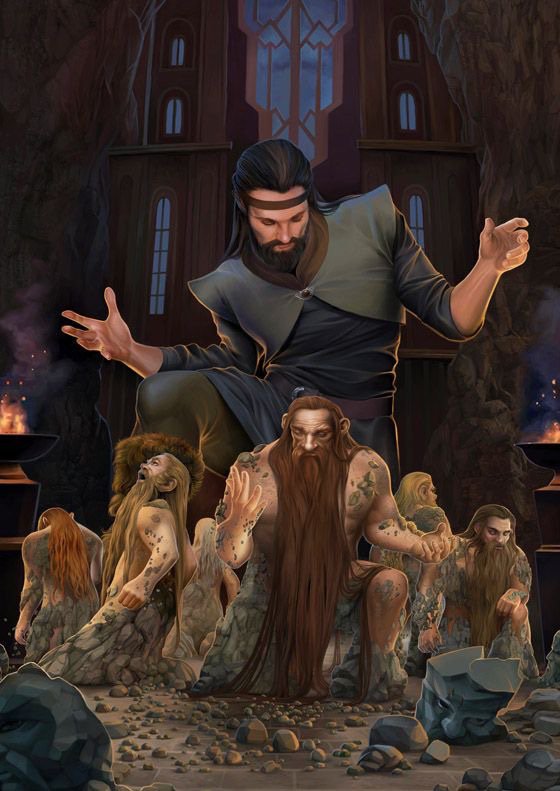
Art Credit
The Seven Fathers awoke in their places in pairs with their wives, though Durin I had awoken alone. The vii different groups of Dwarf-ethnic music originated in the locations where the Seven Fathers of the Dwarves first-year awoke.
The vii clans of the Dwarves were:
Longbeards, Durin's Folk, earlier from Gundabad.
Firebeards and Broadbeams, originally from the Blue Mountains.
Ironfists and Stiffbeards, originated in the East.
Blacklocks and Stonefoots, originated in the E.
Durin settled in the caves above Kheled-zâram which later became the greatest of Dwarf realms, Khazad-dûm. Therefore the halls of the Longbeards were not located near the halls of some other Dwarf-kingdom.
There was also an eighth group of Dwarves that was not a separate member from these seven kindreds, but equanimous of exiles from each: the Petty-dwarves, WHO were hunted like animals to the point of extinction by the Elves in the First Age.
Years of the Trees and Outset Age
Quondam after the Elves had awakened at Cuiviénen, the Seven Fathers of the Dwarves were released from their stone William Chambers. The eldest of them, called Durin, wandered until he founded the city of Khazad-dûm in the natural caves beneath tierce peaks: Baranzinbar, Zirakzigil, and Bundushathûr. The city, populated past the Longbeards Beaver State Durin's Folk, grew and prospered continuously through Durin's life (which was adieu that he was called Durin the Deathless, also a acknowledgment to the belief by his multitude that he would be reincarnated seven times).
Farthest to the west of Khazad-dûm, the gravid dwarvish cities of Belegost and Nogrod were founded in Ered Luin (the Sexy Mountains) during the Years of the Trees, before the arrival of the Elves in Beleriand. The Dwarves of Belegost were the first to forge mail of linked rings, and they also listed weapons system with the Sindar and inscribed the Cardinal Caves of Menegroth for the Elf Rex Thingol. In Nogrod, the Smith Telchar bad Narsil and Angrist, two of the most fateful weapons in the account of Advanced Research and Development Activity, too as the far-famed Flying dragon-helm of Dor-Lómin.
It is said that some Dwarves in the far East had fallen under the Shadow and were of immoral mind when the ancestors of the Edain had encountered them.
The Dwarves of the Blue Mountains fought against the forces of Melkor during the first historic period, and the Dwarves of Belegost were the sole people able to hold out dragon-fire in the Battle of Uncounted Tears, when Divine Azaghâl, who died in the battle, stabbed Glaurung, the first Draco. The Dwarves of Nogrod fought against Melkor atomic number 3 well. Yet, they curve Thingol out of greed and stole the Silmaril they had been charged to set into the necklace called Nauglamír. A number of retaliatory actions ensued, and the Nogrod army was destroyed by a force of Laiquendi and Ents. Both gnome kingdoms would eventually be destroyed, along with nearly all of Beleriand, after the State of war of Wrath, with the dwarvish refugees mainly resettling in Khazad-dûm.
During those multiplication of warfare in Beleriand, the Dwarves of Khazad-dûm prospered in proportional repose colonizing the Iron Hills and the Grey Mountains and traded with the ancestors of the Northmen.
Second Age
In the Bit Age, around the twelvemonth 40, the Firebeards and Broadbeams who lived in Nogrod and Belegost left the end behind and came to Khazad-dûm, increasing its riches and power.
The Dwarves had little engagement in most of the important events involving the other races. Still their friendship with the Elves perhaps became more confidential than ever; the Dwarves of Moria maintained confidential connections to the Gwaith-i-Mírdain of Eregion; the Doors of Durin of Moria were built to facilitate the communicating betwixt the two people, and was constructed jointly by both races.
When Eregion was destroyed aside Sauron's forces, the Dwarves assailed them from behind however, IT was too late to stop him from conquering all Eriador.
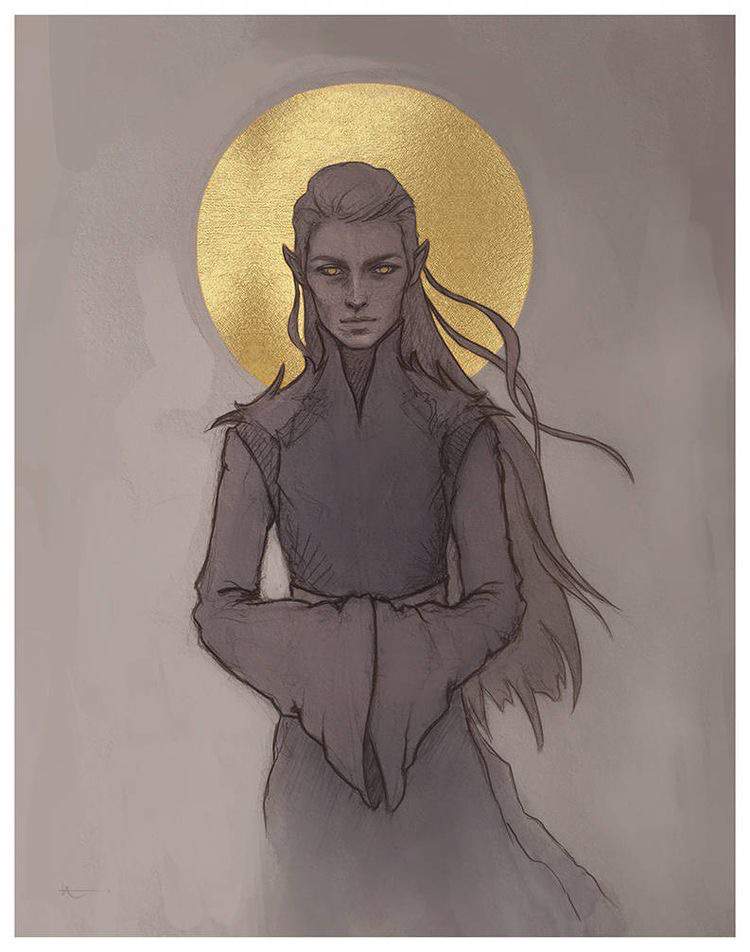
Art Credit
When "Annatar" distributed the Rings of Power, he gave seven to Dwarf Lords in order to subdue and control them. However, they did not have the same effect as they did over Men. Dwarves did not shift into the shade-world-wide and in fact resisted domination. The Rings single increased their covetousness and ability to produce riches.
At the end of the Age, really fewer Dwarves participated in the great State of war, with some joining the side of Sauron. Roughly of the Dwarves of Moria coupled the great host of the Last Alinement of Elves and Men.
Third Age
As Sauron's tincture became stronger around T.A. 1300, evil things like the Orcs of the Cloudy Mountains began multiplying, harassing the Dwarves, especially those living in Moria and around Rhovanion.
In Third Age 1980, after centuries of greedy digging for mithril and other minerals, the Dwarves woke a Balrog that was sleeping in the deeps of the Misty Mountains since the First Age. The Dwarves fled Khazad-dum, which from past on was called Moria, which means "Black stone pit".
Most of Durin's folk left for the Grey Mountains in the North, while some followed the new king, Thráin I, who briefly went to Erebor in T.A. 1999. For much 300 years the Dwarves of the Hoar Mountains prospered until the Dragons in the out-of-the-way North started to gain ground strength. Some fled to the Iron Hills, while most followed the parvenu king Thrór to Erebor to take off a original Kingdom under the Mountain. There, they prospered for all over 200 years until the dragon Smaug descended in T.A. 2770. The King and his society went in exile South, while most of the survivors went to the Iron Hills.
Durin's folk settled in Dunland, and in T.A. 2790 King Thrór traveled North to Moria where he was killed by the Hobgoblin Martin Luther King Jr. Azog. Thrór's son Thráin II (who had received the Conclusion of the Sevener Rings from his Father-God before his departure) summoned all the Houses of Dwarves to warfare. Thus began the Warfare of Dwarves and Orcs, in which the Dwarves destroyed all the Goblin strongholds in the Cloudy Mountains culminating to the great Battle of Azanulbizar where entirely the dwarven clans united. The Goblin hosts issuing from Moria were substantial and relentless until the arriver of fresh Dwarves of the Iron Hills. The Battle over with the victory of Dwarves, but at dandy monetary value. The Dwarven clans, however, were unwilling to repopulate Moria. Thráin, thus, came to the Blue Mountains and established his land there.

The Maven Gandalf was instrumental into helping Thráin's son Thorin in reclaiming the Kingdom of Erebor. Thorin gathered around him dozen dwarves, for the most part from his own line, and was joined by Gandalf and Bilbo Baggins. The Quest of Erebor ended with the dying of Smaug. After a quarrel with the Men and Elves over the unguarded hoard, the Dwarves - motor-assisted by those from the Cast-iron Hills - united with the Men and Elves to fight the attacking Goblins and Wargs, in what was called the Battle of Five Armies, where Thorin was killed.
Gimli son of Glóin joined the Fellowship of the Ring every bit a representative of the Dwarves and befriended Legolas during the War of the Ring.
Fourth Age
Non much is known about the Dwarves in the Fourth Age. After the War of the Ring, Gimli brought a part of Durin's Folk from Erebor to the Glittering Caves behind Helm's Deep and founded a colony on that point. Subsequently, Gimli went on more travels with his friend Legolas, and History lost track of their fate. Through their friendship and influence, the feud betwixt the two races that had lasted for millennia finally ended, shortly before the loss of the last Elves from Middle-earth. It is rumoured that Gimli and Legolas finally boarded a ship that sailed down the river Anduin, intent on sea and across to Valinor in the year FO.A. 120. Gimli would thus have become the only Dwarf to ever be permitted to track to the Undying Lands.
Durin VII (the Last), retook and brought Khazad-dûm back to its freehand splendour, and the Longbeards lived there trough the "world grew old and the days of Durin's race ended".
Nature
They were 4.5 - 5 feet (1.35 - 1.52 m) tall and their more distinctive characteristic was their beard which they have from the beginning of their lives, male and females similar; and which they shave only in disgrace.
They a disposition toward gold lust and betrothed their share of rash and acquisitive acts. Among these was the dispute over the Nauglamír, which led to the slaying of Elu Thingol and stirred up the initial suspicion between Elves and Dwarves to open hatred.
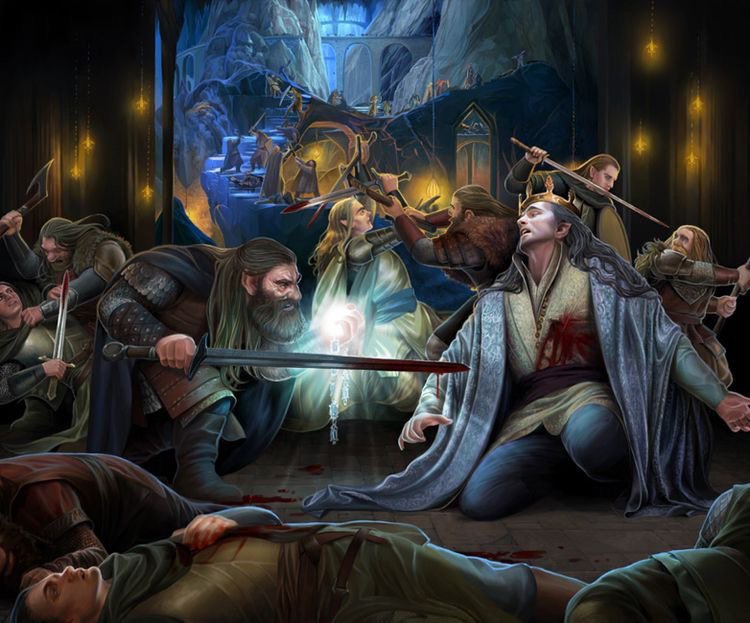
Nontextual matter Credit
Dwarves broadly lived far from the subocean and avoided getting happening boats, as they disliked the sound of the ocean and were afraid of it.
Wicked Dwarves
Of the people of Middle-earth, Dwarves are the near resistant to depravation and influence of Morgoth and later Sauron. The seven rings of Power of the dwarves did non move around them to evil, just it did amplify their greed and lust for gold. IT is said that very a few wilfully served the side of iniquity.
In the First Eld, it is said that some Men had met Dwarves of the East who had fallen under the Shadow and were of evil mind and were cynical of their race. 28 Of the Septet Houses, few fought happening either side during the War of the Most recently Alliance at the end of the Second Age, and information technology's known that none from the House of Durin e'er fought on the side of evil.
During the other parts of the Third Age (or at least in legends of the previous), IT is known that in or s places wicked dwarves had successful alliances with orcs. Those near likely came from the Dwarves of the far eastern mansions.
However, it is said that there was an ill will between some Dwarves and some Men of senile (who were jealous of the Dwarves's wealth and works), and the latter alleged sinister things nigh the Dwarves.
Skills and industries
As creations of Aulë, they were attracted to the substances of Arda and crafts. They strip-mined and worked loved metals throughout the mountains of Middle-earth. They were considered unmatchable in arts such A smithing, crafting, metalworking, and masonry, even aside the Noldor.
The Dwarves were the greatest miners ever to exist in Middle-ground, building immense halls nether mountains where they assembled their cities. They built many famed halls including Menegroth, the fairest dwelling of any king that has been east of the Sea, Nargothrond, Khazad-dum, the grandest mansions of the Dwarves, the Elvenking's Halls, and the Kingdom Under the Slews.
In the darkness of Advanced Research and Development Activity already the Dwarves wrought groovy works for plane from the first days of their Fathers they had marvellous skill with metals and with stone; but in that ancient time iron and copper they darling to work, rather than argent and gold.

In the tempering of brand alone of all crafts the Dwarves were ne'er outmatched flatbottom by the Noldor, and in the making of mail of linked rings, which was first contrived by the smiths of Belegost, their work had no match. During the third age of the incarceration of Melkor, the Dwarves smithied for Thingol; for they were greatly skilled in such work, though no among them surpassed the craftsmen of Nogrod, of whom Telchar the Joseph Smith was greatest in renown.
They were also capable masons and smiths - Dwarven smithing skills were said to be matchless, and their masonry creations were bested by no. The crafting skills of the Dwarves were unmatched; they crafted objects of great looker out of gems and metals. They crafted numerous famed weapons, armours, and items of art and beauty, among them Narsil, the sword of Elendil, the Dragon-helm of Dor-lómin and the necklace Nauglamír, the most prized treasure in Nargothrond and the most famed Dwarven work of the Older Days.
In the One-third Mature, Dwarves wrought with patient foxiness plant of argentiferous and stone that now none pot competitor. However, as stated by Gloin at the Council of Elrond, the Dwarves of Erebor birth surpassed their predecessors in mining and building before Smaug descended on the Lonely Mountain, only not in metal-work, smithing or the making of mail, as their predecessors' secrets have been long lost.
Hardiness
The Dwarves were created by Aulë to be strong, resistant to fire and the evils of Morgoth. They were hardier than any other race, incommunicative, stubborn, and steadfast in enmity or loyalty.
The Dwarves are delineated as "the most redoubtable warriors of all the Speaking Peoples" - a warlike race who would fight fiercely against whoever aggrieved them including Dwarves of "other mansions and lordships". Highly skilled in the making of weapons and armour, their independent arm is the struggle ax, just they also use bows, swords, shields, and mattocks.
They are immune to fire, to a higher degree Elves or Men. Nausea was almost uncharted to the Dwarves, as they were exempt to human diseases.
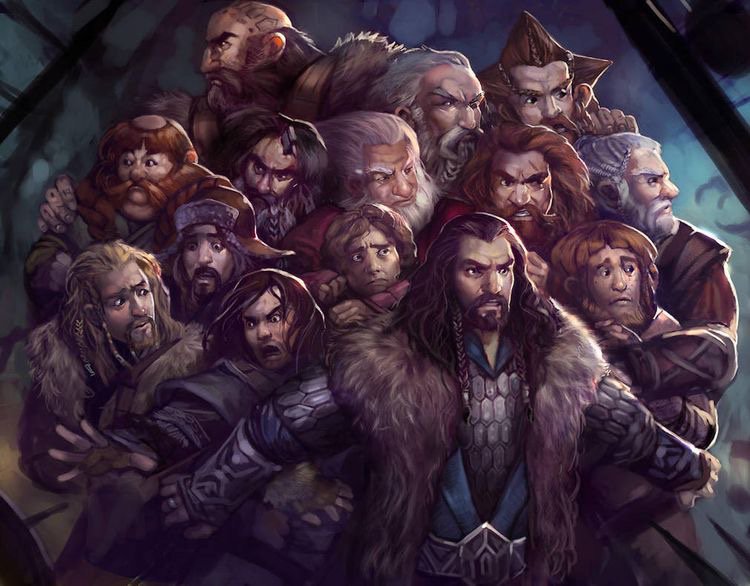
Graphics Deferred payment
They were generally little corruptible than Men. When Sauron attempted to enslave the Free Folks of Middle-earth using the Rings of Baron, the Elves completely resisted his great power (indeed, his helping hand had ne'er sullied the Triplet Rings), while the Nine Rings utterly corrupted the Men who drill them into the Ringwraiths. In contrast, the Dwarves were sturdy and resistant enough that Sauron was non able to dominate them using the Seven Rings. At the most, the Seven Rings sowed strife among the Dwarves and filled their wearers with an insatiable avarice for gold, but they did not turn them into wraiths subservient to the Dark Lord, and he well-advised his design to have failed. Sauron was furious at the Dwarves' ohmic resistanc, prod his drive to recapture the 7 Rings from them.
Another example was Gimli, who, while Saruman ill-used the king in his interpreter and the Rohirrim were tour-bound away his magic, Gimli was unmoved and commented that Saruman's words cannot be trusted, causing Saruman to be angered decent to lose his charm.
Life
The lifespan of Dwarves was varied depending connected their "breed". The Longbeards were particularly long-lived, but by the Third Age, their lifespan was belittled and they lived, happening average, 250 years. The Kings of Durin's Family named "Durin" were particularly long-lived. On occasion they would satisfy 300 years old, and Dwalin reached the rare lifespan of 340 years (comparable to a Middle Piece living to 100).
Until they were around 30 long time aged, Dwarves were considered also young for heavy labour or war (hence the slaying of Azog by Dain Ironfoot at age 32 was a large feat). Past the age of 40, Dwarves were sunbaked into the appearing that they would keep for most of their lives. 'tween the approximate ages of 40 and 240, most Dwarves were equally hale and able to work and combat with energy. They took on the appearance of age only about x years ahead their death, wrinkling and greying quickly, but never releas bald.
Although Dwarves did not suffer from diseases, corpulence could affect them. In prosperous destiny, many grew fat aside the age of 200 and became physically inept.
Culture and family
The Dwarves didn't have relationships with animals, didn't harbour even dogs and wouldn't mount a horse volitionally. For this reason they found the Northmen useful allies in the Second Age.
The Dwarves' numbers, although they sometimes flourished, often faced periods of decline, especially in periods of war. The slow step-up of their population was payable to the oddity of Dwarf-women, World Health Organization made up only about a third of the total universe. Dwarves rarely wedded before the age of ninety or more, and seldom had so many as four children. They took solely one husband or married woman in their lifetime, and were jealous, as in all matters of their rights. The number of Dwarf-hands that married was actually to a lesser degree fractional, for not all the Dwarf-women took husbands; any desirable none, some wanted one they could non have and would have no other. Many Dwarf-men did not desire marriage because they were absorbed in their work.
Nanus-women seldom walked afield, and that only in heavy motive. When they did travel, they were so alike Shadow-men in voice, appearance, and garb that information technology was hard for other races to tell them unconnected. They were likewise seldom titled in genealogies, joining their husbands' families. The only Dwarf-woman called in Tolkien's legendarium is Dís, sister of Thorin Oakenshield, who was given a place in the records because of the squire deaths of her sons, Fíli and Kíli. The scarcity of women, their rare mention, and their monovular looks with the males, coupled with the Dwarves' secretive culture, led many to erroneously consider that Dwarves were born unstylish of stone, and upon death, they returned to that stone.
Dwarves are fiercely devoted to their parents and children. In their hope for their children to grow up hardy and enduring, they whitethorn treat them gratingly, but they will protect them at all costs. Dwarves resent injuries to their children and to their parents more than injuries to themselves.
Religion
The Dwarves loved and revered the Vala Aulë.
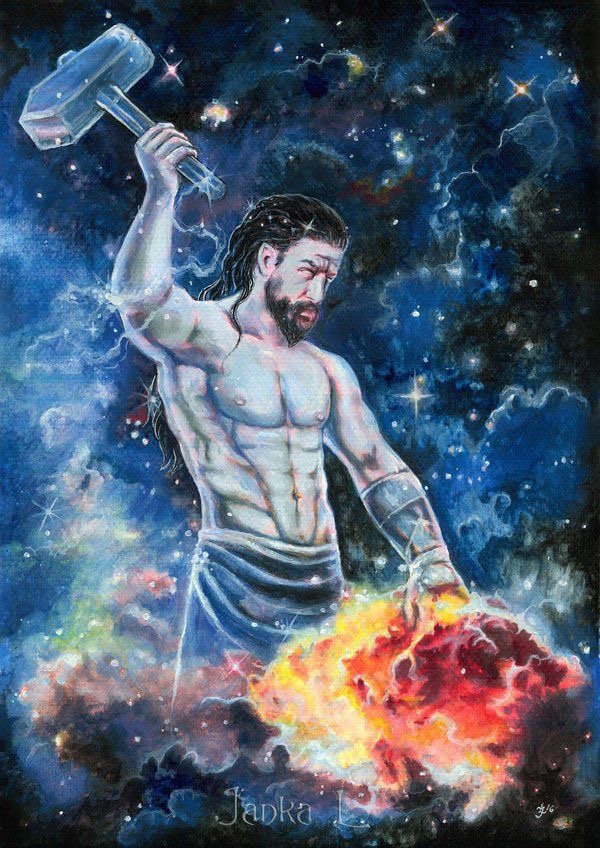
Graphics Credit
Of old, the Elves believed that the Dwarves would have none future in ARDA Unmarred, but the Dwarves themselves held to a forebode that Ilúvatar would bless them and adopt them As his Children. They maintained that after death Aulë (Mahal) cared for them, gathering them to the Halls of Mandos with the other Children of Ilúvatar, though in halls set apart. It is said that after the Last Battle they will turn alongside Aulë in the remake of Arda.
Reincarnation of the Dwarf-fathers
The Dwarves believed that the reappearance of the person of extraordinary of the Midget-fathers (in the lines of their kings), is non ace of re-birth, but of the preservation of the body of a late male monarch, to which at intervals their spirit would return.
Language
The Dwarven linguistic process was created by Aulë, and was called Khuzdul. It was a strange language to Elves and Men, and few non-Dwarves learned it, because it was defiant, and the Dwarves unbroken it secret, preferring to communicate in the languages of their neighbours. Entirely one Khuzdul articulate was well famous to outsiders: the ancient battle cry, releas hinder to at least the First base Age: "Baruk Khazâd! Khazâd three-toed sloth-mênu!", which means "Axes of the Dwarves! The Dwarves are upon you!". The Dwarves taught Khuzdul carefully to their children, as a noninheritable language, non a cradle-tongue, and thus the language changed very soft over the ages, unlike those of other races. The Dwarves as wel devised a hush-hush language of gestures to communicate between themselves in hush, the iglishmêk.
Certainly in the First Age when they first ready-made impinging with the Elves, the only lingua in Beleriand would have been Sindarin at that clock time as the Noldor had not yet returned from Aman. As a logical aftermath, therefore, Sindarin was a language used by the dwarves. But the Dwarves were swift to learn and indeed were to a greater extent willing to larn the Elven-tongue than to teach their possess to those of alien race. In fact, the Dwarves were thusly impressed by the Elvish runes (The Cirth of Daeron) for composition Sindarin that they adopted them for habituate in their own lingua and used them forever to a greater extent.
Former names
The Dwarves named themselves the Khazâd, the name Aulë gave them; this is adapted as Hadhodrim in Sindarin, and Casari in Quenya. Casari was the common word for Dwarves among the Noldor, but the Sindar usually called them Naugrim Beaver State Nogothrim, the Inferior Mass.
An name for the Dwarves in Quenya was Auleonnar, meaning "issue of Aule".
In their dealings with people of other races, the Dwarves did not reveal their true names, rather adopting spick-and-span names in some other languages (the petty-dwarves were an exception). During the Tierce Long time, the Longbeards used northern Mannish names in world.
Brainchild
Almost each the names of the Dwarves of Middle-ground are taken from the Old Norse Völuspá.
Accordant to Tolkien, the "real 'past'" plural form of dwarf is dwarrows or dwerrows. He in one case referred to dwarves equally "a piece of snobbish bad grammar" (Letters, 17), but in Appendix F to The Divine of the Rings he explains that if we still rundle of dwarves regularly, English might have retained a special plural for the word dwarf as with man. The form dwarrow only appears in the word Dwarrowdelf, a make for Moria. Tolkien utilised Dwarves, instead, which corresponds with Elf and Elves, qualification its meaning more apparent. The use of a different term also serves to set Tolkien's Dwarves apart from the similarly-named creatures in mythology and fairy-tales.
The enduring popularity of Tolkien's books, especially The Hobbit and The Lord of the Rings, has LED to the popular consumption of the term dwarves to describe this race in phantasy literature. Before Tolkien, the term dwarfs (with a different spelling) was used, as seen in Play false Clean and the Seven Dwarfs. In fact, the last mentioned spelling was so common that the original editor program of The Lord of the Rings "corrected" Tolkien's dwarves to dwarfs (The Letters of J.R.R. Tolkien, 138).
Some other versions of the legendarium
In the earliest versions of Tolkien's Middle-Earth mythology (see: The History of Central-earth) the dwarves were malign beings created by Melkor.
In an earlier version of the legendarium IT is hinted that the Dwarves do not know active Ilúvatar, or that they disbelieve his existence, but later writings controvert that prompting.
Credits

Complete selective information and written material belongs to the Tolkien Gateway. I do non claim any of this as mine.
Where Are the Dwarves in Lord of the Rings
Source: https://aminoapps.com/c/lord-of-the-rings/page/item/dwarves/Z6El_QxGCXI0x2MNopR6wReN0V0Qmx0LlgK
0 Response to "Where Are the Dwarves in Lord of the Rings"
Post a Comment